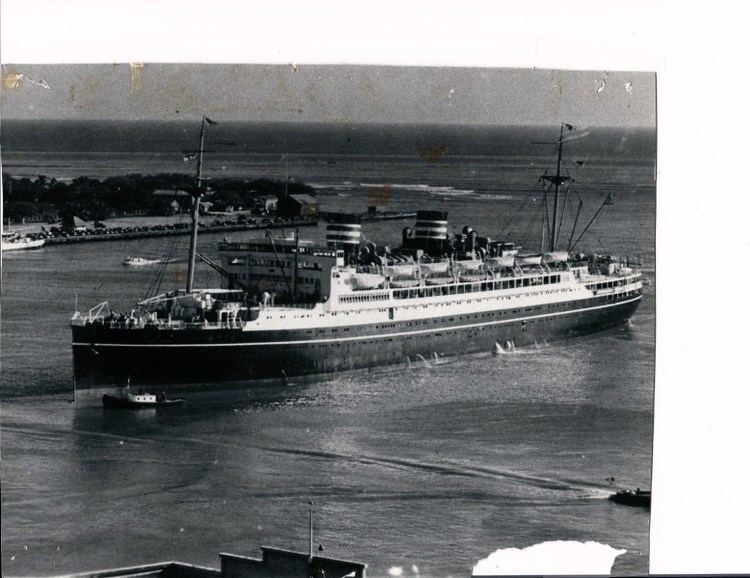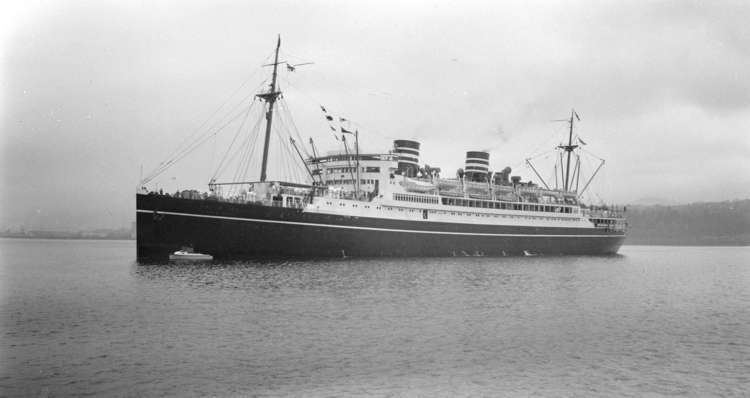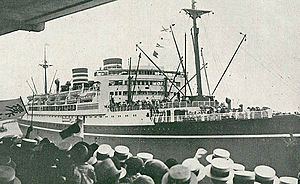Name Asama Maru Yard number 450 Completed 15 September 1929 Construction started 10 September 1927 Length 178 m | Laid down 10 September 1927 In service 1929 Launched 30 October 1928 | |
 | ||
Builder Mitsubishi Heavy Industries, Ltd. | ||
Asama maru in sf
The Asama Maru (浅間丸, Asama maru) was a Japanese ocean liner owned by Nippon Yusen Kaisha. The ship was built in 1927–1929 by Mitsubishi Shipbuilding & Engineering Co. at Nagasaki, Japan.
Contents
The Asama Maru was built for the trans-Pacific Orient-California fortnightly service; and she was characterized as "The Queen of the Sea." Principal ports-of-call included Hong Kong, Shanghai, Kobe, Yokohama, Honolulu, Los Angeles & San Francisco. On her fourth voyage from Yokohama to San Francisco, the speed of the ship's crossing surpassed the previous record.

The vessel was created as a twin of the Tatsuta Maru; and both ships were named after important Shinto shrines.

History

The first passenger liner built by NYK was Asama Maru. The ship was built by Mitsubishi at Nagasaki on the southern island of Kyushu. The Asama Maru was launched on October 30, 1927. She left Yokohama on September 15, 1929 on her maiden voyage to California.

The 16,975-ton vessel had a length of 583 feet (178 m), and her beam was 71 feet (22 m). The ship had four diesel motors, two funnels, two masts, quadruple screws and a service speed of 21 knots. The Asama Maru was the first Japanese passenger liner to be propelled by diesel engines.

The ocean liner provided accommodation for 222 first-class passengers and for 96 second-class passengers. There was also room for up to 504 third-class passengers. The ship and passengers were served by a crew of 330.
Pacific War
Before Japan's entry into the Second World War she was intercepted by the Royal Navy light cruiser HMS Liverpool 35 miles (56 km) from the coast of Niijima on 21 January 1940. Alerted to reports that Axis sailors in the United States were preparing to arrange transport to Germany, the British Government had authorised the Commander-in-Chief, China Station to direct a warship to detain certain passengers providing the coast of Japan was not within sight. The Liverpool removed 21 of the ship's passengers believed to be survivors of the scuttled German liner Columbus. The Government of Japan condemned it as an abuse of belligerent rights and formally protested the action, which further escalated tensions between the two countries.
On 25 October 1940, the Asama Maru departed San Francisco with eight officers from the Columbus, and arrived Honolulu on 30 October. On 12 November, they reached Yokohama.
In 1941 the ship became a troopship for the Imperial Japanese Navy. In the summer of 1942, it was used in the repatriation of the prewar diplomatic staffs of Japan and the Allied nations, the exchange taking place at what is now Maputo, Mozambique. In transporting Allied prisoners, it was amongst those vessels which earned the epithet "hell ships."
On November 1, 1944, Asama Maru was torpedoed and sunk by the US submarine USS Atule in the South China Sea 100 miles (160 km) south of the island of Pratas. 98 of 201 crew, 21 of 266 gunners and 355 of 1,383 military personnel and passengers are killed.
